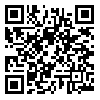Volume 26, Issue 4 (10-2018)
Avicenna J Nurs Midwifery Care 2018, 26(4): 227-236 |
Back to browse issues page
Download citation:
BibTeX | RIS | EndNote | Medlars | ProCite | Reference Manager | RefWorks
Send citation to:



BibTeX | RIS | EndNote | Medlars | ProCite | Reference Manager | RefWorks
Send citation to:
Mohammadi N, Soltani N, Amini R, Tapak L. The Effect of Education Based on Health Belief Model on Preventive Behaviors Towards Cardiovascular Disease. Avicenna J Nurs Midwifery Care 2018; 26 (4) :227-236
URL: http://nmj.umsha.ac.ir/article-1-1824-en.html
URL: http://nmj.umsha.ac.ir/article-1-1824-en.html
1- Instructor, Department of Community Health Nursing, School of Nursing and Midwifery, Hamadan University of Medical Sciences, Hamadan, Iran
2- MSc. Student in Nursing, Student Research Committee, Hamadan University of Medical Sciences, Hamadan, Iran
3- Instructor, Department of Community Health Nursing, School of Nursing and Midwifery, Hamadan University of Medical Sciences, Hamadan, Iran ,royamini@umsha.ac.ir
4- Assistant Professor, Department of Biostatistics, School of Public Health, Hamadan University of Medical Sciences, Hamadan, Iran
2- MSc. Student in Nursing, Student Research Committee, Hamadan University of Medical Sciences, Hamadan, Iran
3- Instructor, Department of Community Health Nursing, School of Nursing and Midwifery, Hamadan University of Medical Sciences, Hamadan, Iran ,
4- Assistant Professor, Department of Biostatistics, School of Public Health, Hamadan University of Medical Sciences, Hamadan, Iran
Abstract: (9238 Views)
Introduction: Cardiovascular diseases are associated with individual behaviors in childhood, adolescence and youth. This article aimed to study the effect of education based on HBM on the prevention of heart disease in female students.
Methods:This pre and post-test semi-experimental study which has two groups was conducted on 126 girls of high schools in 2017. A randomized cluster sampling method and relative randomize method were used in the first and second stages respectively. At first both groups completed a questionnaire and then instructions were given to intervention group in three sessions (1 hour) on the basis of HBM. Two months later, data was collected via questionnaires in two groups again. Statistical analysis of the data was performed by SPSS software, using independent and paired t-test and Chi-square test.
Results: The two groups were similar in terms of demographic characteristics and knowledge and constructs of the health belief model at the beginning of the study and there was no significant difference in analysis (P>0.05). After intervention, the mean scores of knowledge and model constructs, sensitivity, benefits, self-efficacy and behavior had significantly increased in the test group (P<0.05). The perceived barriers were significantly reduced in the test group (P<0.05). There were no significant differences between the perceived severity and the areas of practice according to the t-test results in both the experimental and control groups before and after the training (P>0.05).
Conclusion: According to the results, education based on health belief model increases knowledge and practice in girls; so it is recommended to use this model in programs for the prevention.
Methods:This pre and post-test semi-experimental study which has two groups was conducted on 126 girls of high schools in 2017. A randomized cluster sampling method and relative randomize method were used in the first and second stages respectively. At first both groups completed a questionnaire and then instructions were given to intervention group in three sessions (1 hour) on the basis of HBM. Two months later, data was collected via questionnaires in two groups again. Statistical analysis of the data was performed by SPSS software, using independent and paired t-test and Chi-square test.
Results: The two groups were similar in terms of demographic characteristics and knowledge and constructs of the health belief model at the beginning of the study and there was no significant difference in analysis (P>0.05). After intervention, the mean scores of knowledge and model constructs, sensitivity, benefits, self-efficacy and behavior had significantly increased in the test group (P<0.05). The perceived barriers were significantly reduced in the test group (P<0.05). There were no significant differences between the perceived severity and the areas of practice according to the t-test results in both the experimental and control groups before and after the training (P>0.05).
Conclusion: According to the results, education based on health belief model increases knowledge and practice in girls; so it is recommended to use this model in programs for the prevention.
Type of Study: Original Research |
Subject:
Nursing
Received: 2017/11/15 | Accepted: 2017/12/24 | Published: 2018/03/16
Received: 2017/11/15 | Accepted: 2017/12/24 | Published: 2018/03/16
Send email to the article author
| Rights and permissions | |
 |
This work is licensed under a Creative Commons Attribution-NonCommercial 4.0 International License. |







 gmail.com
gmail.com